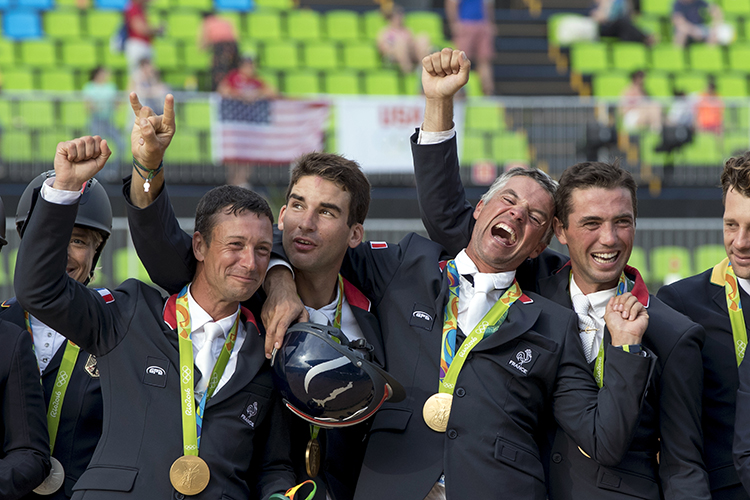
Christopher Hector set out to find the reasons for the French Eventing success at the Rio Games…
I was assisted in my travels by the French international horse marketing body, UNIC, but an added bonus was to meet up with Babette Schily at Pau****. Babette is an astute observer of the French eventing scene – as a rider, as an event organizer, as a co-ordinator of equestrian services and small businesses for the Chamber of Commerce in her region of South West France. Luckily she was the first person we met as we set out to try and unravel the secrets of the French eventing team’s success, lucky in that after a wonderful de-brief on the French scene, she then acted as rounder-upper of interview targets, and interpreter.
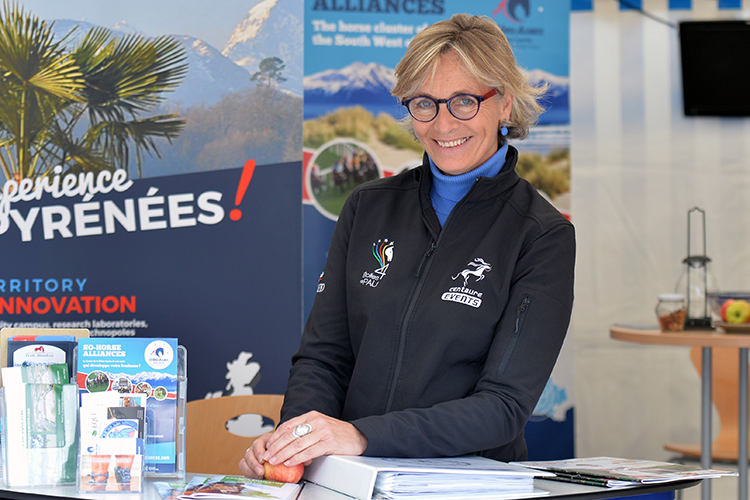
When once the French were too far from the lead after the dressage, at Rio, they were right at the top all the way through, why the change?
“The Germans were always known for very academic riding, they are very disciplined. French people are more inventive, creative and that is how they ride their horses. Horses have more liberty, okay if it is not the right stride, just do something and jump. For the Germans it has to be calculated, not improvised, the French riders leave it to the horse more to take the initiative.”
“Another important point is that the breeding improved and they got better horses – but the French Federation struggled a lot of keep the good horses. When Nicolas Touzaint had very good horses, people offered a lot of money for them and it is very difficult for the owner to say, no I don’t sell this horse, and when you lose a four-star horse, that is very tough for the Federation. So they set up a system to help the owners to keep the horses in France for the French team.”
“Another factor is that some of the riders went over to the UK and took the risk to get training with Andrew Nicholson, with Mark Todd. So the riders went over there and they improved their riding, they became more professional, more experienced – riders like Astier Nicolas, a lot of French riders went over there and were hosted and welcomed by professional riders, and then came back and brought these experiences into the French team.”
“What is also very encouraging is that our French team won the European Young Riders Championship, so we have good horses and good young riders coming up.”
“There was a change in the training, Thierry Touzaint is back as the coach, there was a change in the Federation management, now you have a girl like Sophie Duborg, she’s a very good team manager, very human with good human values, that’s what they needed. You can be very strong in technique and discipline, but if there is not a good feeling between riders, the owners… it has to be a team, that is very important.”
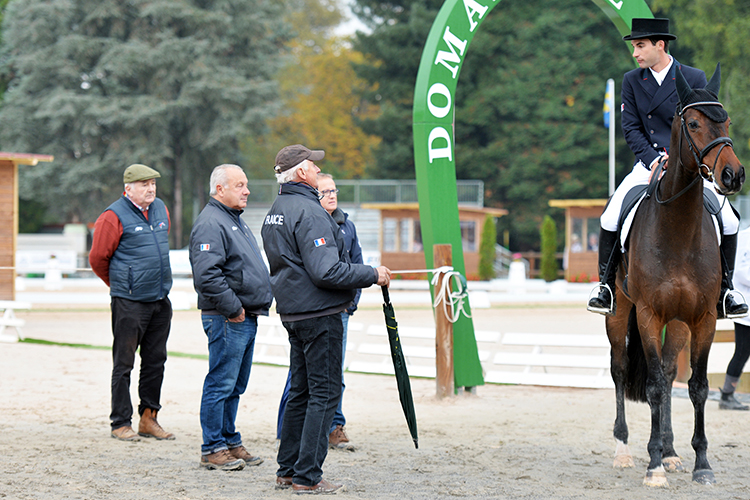
The French team in action. Left to right: Michel de Chateauvieux (Astier’s owner), Thierry Touzaint, Serge Cornut and Michel Asseray debrief Astier after his dressage test
Has the medal in Rio had a big effect in France?
“I would like to say yes, but it is too early to say. I was asked do you have more riders, members of your Federation? Often sports like judo they have a big boost in numbers if they have a gold medal and it would be nice to know if it is happening in equestrian but we don’t have the numbers yet. There has been a huge media impact, media that never talked about riding or equestrian sports, they started to be interested. People who never talked about horses before come up to me and say, wow, that was great, the French teams.”
“Still our riders have to struggle really hard to find private sponsors: equipment sponsors, for clothes, for their lorry, the fences at home.”
Do you have a tradition of owners – in England there is Lady This, and the Honorable That, and they buy horses for William Fox-Pitt and the like…
“Unfortunately much less than in Britain. What is coming up now is syndicates, it is something that exists a lot in racing, and now it starts to come in sports, that riders have several owners for one horse because four-star horses are so expensive that you need several owners to get around that. Thomas Carlile for example, he has a very good syndicate, and I think that is the future way for the sport, and that is why it is important to be a real professional and communicate with the owners and get them to the events and make sure they have a good time, like they do in the UK. Have a good time together, network, look at the syndicates of William Fox-Pitt, some have 30, 40 people and that is they way for the future. In eventing we don’t have enough prizemoney to live from it, so they have to trade horses, they have to have sponsors, they have to learn to network.”
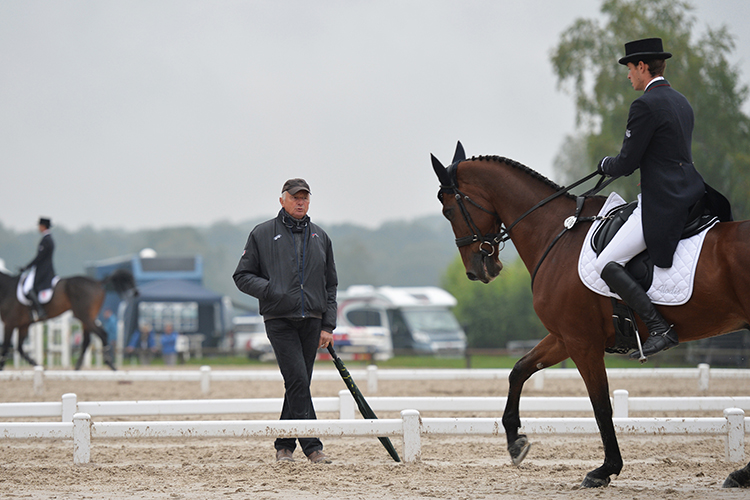
Serge Cornut works in another of the French young guns, Maxime Livio
One of the first people Babette introduced us to was Michel Asseray who is the national technical director for eventing, in charge of co-ordinating the coaching.
“I have three trainers, one for the seniors, one for the juniors and one for the pony. Two trainers, one for the dressage, one for the jumping, two vets, one doctor.”
“I work at Saumur with the two trainers, Thierry Touzaint and Serge Cornut. The riders come to the centre. We have an elite list for the big competitions – the JO-JEM – potential riders for Olympics or WEGs. This group comes to Saumur in January and February, they come for three week long training camps at the beginning of the season. We also go to all the events and work with the riders there. All the weeks I go to competitions with Thierry Touzaint, he is the specialist for cross country, but when we go to the competitions, we have also a specialist for dressage. Some of the riders also have their private coaches and they are welcome to come to the special training camps at the beginning of the year so we are working together, the national trainer, the private trainer and the rider.”
“All the riders on the JO-JEM list have a program that is drawn up by myself, and Thierry Touzaint and the private coach, if there is one. And the owner! They decide which competitions to enter – which is the objective, and the steps to get there.”
(Article continues below)
It’s pretty impressive watching the team at work at competitions. We saw them at Pau Four-star, and a week later at the World Young Eventing Horse champs at Lion d’Angers. They watch the dressage warmups and the tests, and the rider gets an instant de-brief as they come out of the arena, and at times it looks as if this is not the most comfortable place to be if you are a rider. They are also a formidable presence during the cross country and showjumping phases…
Where does the funding for this program come from?
“From our Equestrian Federation and from the Government. The riders on the list have a special lump sum for the day, €200, when they are at the training camp, or the competition – and that is paid by the government, and the Federation refunds to the expenses for transport, and the accommodation expenses.”
Do you have a program to help the owners keep the horses, and not sell them all to William Fox-Pitt…
“We try to sell a dream always, but there is not a lot we can do.”
You don’t buy horses for the riders?
“Never.”
Insure them?
“We had insurance for the horses to go at Rio, but not here, or any event in France.”
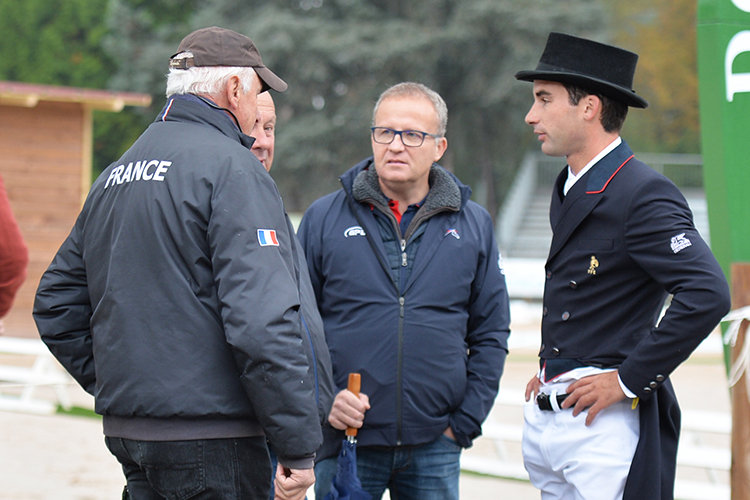
Astier listens while the three wise men offer their advice
In the past, the French team has always been strong in the jumping, but sometimes too far behind after the dressage but at Rio, your team was right up there from the beginning…
“I came to the team four years ago, after London. It was a new team and when we analysed it, it was like you said, we had to work on the dressage. We chose very good dressage trainers and we asked the riders to choose horses with more quality for dressage. A better selection, with the breeders and the horses – this is very important for the new eventing.”
“I don’t think there is so much a French style. Like everywhere, the riders have to find a horse that is calm for the dressage and keeps his energy for the cross country, you have to find the right balance. The trainer who is in charge of the dressage Serge Cornut, he was a rider with the Garde Républican, he understands that he has to respect the horse in its entirety and not try to make him into a Grand Prix dressage horse. It is not possible for an eventing horse to have the same dressage as a dressage horse, because the cross country requires a special balance. I think Serge understands the horse for eventing and he makes a good job.”
Serge looked great riding for France in his Garde Républican uniform. He was a member of the French team at the Barcelona Games in 92, and the Euro Champs in Lipica in 93.
“For me, I am a judge, an international judge for four-star eventing, and I know what the judge wants to see, I know what you have to do to get a good mark. The picture you present to the judge is very important. If you look tense, it is easy for the judge to mark you down – the top riders make it look easy, look at William Fox-Pitt, always 7, 7, 7, 8, 7, 8.”
Is it important for your riders to go to the UK and compete there?
“I’m not sure because we don’t have a lot of horses and when you go to Badminton or Burghley, it is difficult for the horse. This group, JO-JEM, I am very protective of the horse. It is important to practice at the top level, but not a lot. I think in France we have a good program of competitions but yes, sometimes you have to go to those big competitions to see where you are, but not a lot. This year, we go one time to Great Britain, to Chatsworth, and we made a good preparation for the Olympics because we were first, second and third. And the judges said – oh, the French have arrived.”
Thibaut Vallette on Qing du Briot – riding for the team
I thought at Rio, that your team was riding very tactically – they weren’t going out to win an individual medal, it was about the team…
“When we decided on the team, Thierry Touzaint and I, we went to the competitors and said, first we want a team medal. Even if you are in first place after the dressage, we are going for the team medal. An individual medal is super but the riders accepted that first they were riding for the team medal.”
“I think in Rio we had a very strong team, incredible, incredible, with real team spirit. It is a young team, a team that has not competed at Olympics, but it is a team that has participated a lot at a national level. Two weeks before Rio we had training camp and it is very important to make a group. We lived in the same house – the group was incredible. The four riders, Thierry Touzaint and me, we lived at the Olympic Village and we were always together. All the three meals, together, always together, it was very important.”
You seem to have young riders coming to the top in eventing in France…
“We had six riders in Caen at the WEG, and none of them was in the Olympic Team. The horses we had for Rio, we prepared at the Europeans the year before.”
Mathieu Lemoine and Bart L, taking the long options to get home safely
How do you make the transition from Young Riders to the senior team?
“That is my job. For the young riders to go to the seniors, we use a lot the nations cups. It is not easy to ride in a team, it is different, if you have always ridden as an individual, it is not easy. Astier when he came into the team, he didn’t like the idea of going out in first place. When Thierry and I went to talk to him, he said, no not me! Always I am three or four. Thierry said, I am the trainer, and you are first. You’re sure? I’m sure. If he had ridden at three or four in Rio, there would have been no medal for France and no medal for Astier. Because we ride for the team, when the second rider, Karim Laghouag had problems, we decided to take the options for riders three and four. If Astier had been three or four and had to take the slow options, no medal for Astier, no medal for France – Thierry is a genius. I think this trainer is a genius guy. He doesn’t speak a lot, but he knows the sport at the top very well.”
Do you try very hard to take care of the owners?
“We try but we are not as good at it as the British. I don’t think we do enough.”
Are you going to win a gold medal at the WEG?
“I’m not sure I am going to continue at the moment. Next month we have elections for the new president of the Federation and then I will decide if I continue on in the job. It is also a personal decision because if I take the job again, it’s a lot of travel, a lot of time away from my family, it’s a hard life, so I have to think about all these things before I decide to go for four more years. It’s a tough job, it takes a lot of energy and responsibility, you are always giving to the riders, and the owners and the parents. Especially after you win a gold medal, then the pressure goes on – that’s why I am very happy with the results of the Young Riders in Italy, because it means there are more riders coming on.”
“There was a big difference – in the four years before London, they won eight medals, and in the time I was there, the four years before Rio, we won twenty five medals.”
Karim Laghouag and Entebbe – they had two stops and the French team went to Plan B
Were you an eventer yourself?
“Small, small – but I am a four-star judge, I have judged at all the four-stars in the world.”
It must be confessed that Michel and his chief coach, Thierry Touzaint both look a bit like cuddly teddy bears, but as you might have gathered from when Michel was talking about the order of go for the team, these are very tough teddies.
Thierry Touzaint was an international rider for 20 years and rode in the Olympic Games in Montreal in 1976. In 1993, the national trainer stepped down, and the riders asked the French Federation for Thierry to be the new trainer. He stepped down after the Euros in Fontainebleau in 2009 but after the French went badly at the London Games in 2012, the French Federation asked him to come back.
Are you a disciplinarian – do you make the riders do what you want them to do?
“I give my orders, I make the decisions and explain these things very directly to the riders. The riders and the team listen, and accept this situation. Of course they can discuss these things with me, but I am very direct – I want you to do that, and that and that. I think this is accepted because I have an authority because I have been a trainer for a very long time. It’s a relationship based on confidence, the riders have confidence in me. They know my system works.”
Is your system of training very ‘French’ or is training the whole world over, very similar?
“What helps me in my work, is that I have a circuit in France, a national circuit of events where we build up the riders and their horse and the team. I work the riders on this circuit very closely in association with the course designer, Pierre Michelet, we are very close friends, and we know exactly what we can ask the horses to build them up and progress their career.”
“Because we don’t have a lot of top level horses, we train them first in France until they are ready, and most times when we do decide it is time to go to Burghley, or Lumühlen, they end up on the podium, because I chose the right time for them to go.”
(Article continues below)
When you came to Rio, when did you know you were going to win the gold medal?
“You always dream of a medal when you go to an Olympics. It was not a surprise because we knew we had a really good team and we were convinced we would win a medal – gold, silver or bronze. It only became a gold medal right at the very end in the showjumping. We were sure we would come back with a medal, but which one, you never know.”
Did you tell your team to take the options and ride like a team on the cross country?
“I know very well each combination, I know what they are able to do. So my decision to send out Astier Nicolas as number one, that was my choice because it was the most experienced combination and our best chance. I sent him out first, and then adjusted the others according to the results, and gave them specific instructions based on what I knew they could do. I am very strict in my orders, and the team medal is the first objective. For example, Mathieu Lemoine had a very good dressage test, he was in fourth place, but I said to him, whatever you do, where-ever you are placed after the dressage, you will be fourth on the cross country and you have to accept your place in the team. If you don’t accept that, and I remain team trainer, you will remember the next four years – they will not be very pleasant.”
Will you stay on as trainer?
“If the French Federation asks me to stay on, I will accept.”
Do you have more young riders coming on, to keep the French team strong?
“Right now, the existing team is very good and still has a future. None of them was at the WEG in 2014, it is a new team and they can continue at the highest level. Our young riders won a gold medal in the Young Rider Championships in Italy, so that is promising, but I know the gap between young riders and senior riders is great, and not easy to bridge, but I am optimistic.”
Pierre Michelet – France’s secret weapon?
It was time to talk to another crucial member of the French team, Pierre Michelet, the course designer. I can think of no country where a course designer works so closely with team management:
Thierry Touzaint and Michel Asseray see you as part of their team, in terms of preparing the French riders for international success…
“I visit with Thierry Touzaint, all the main events and we decide what kind of fences we are going to build. What kind of questions and education we will give to the riders and the horses.”
Your style of course building is very distinctive…
“I don’t know, I try not to always make the same thing but normally, I have my own style.”
What is that style?
“I don’t know. I know from some of the discussion from the foreign riders, that I am building very long strides in the combinations, very technical questions.”
Does your philosophy of course designing come from your own experiences as a rider?
“Probably, but my experience as a rider is now a bit far away. I have been designing for thirty years and I stopped riding internationally 20/25 years ago. When I was a rider I was also an organizer of big events in France, I was rider, course designer and course builder because I was building my own courses. Then some people asked me to help them, and it got bigger until I was a full-time course designer.”
When you went to Rio to build the Games course, what were the thoughts you had…
“It was not the first big course. I had already done twice European Championships, one WEG, European ponies, juniors, young riders – I have a lot of experience. This has been my full time job for twenty years now and I am in charge of between 15 and 20 international events in a year.”
Many people have commented that your Rio course was the first really tough four-star course since Mike Etherington-Smith’s course…
“In Sydney, yes. I think the Olympics have to be the top of the sport, we have to make a true course for the Olympics.”
You were prepared to take the risk?
“It’s not really a risk because the risk is when you are unlucky. You can have an accident on a very small easy course, the same way as you can have one on a difficult course. When the course is difficult, the riders respect the fence and they try to ride more technically, more rationally and we have seen in Rio, after the first round of the teams, everybody said, okay we have to ride with our heads, and finish the course and not go as quick as possible.”
Why do you think the team was successful in Rio?
“I think it is an advantage for the French to have me as the course designer. They know my style, they have been riding my courses for twenty years. Before Rio, the Brits said, oh it was not good that it was the same course designer for the WEG and the Games, a French one, and I said but it is always the Brits that are designing the courses. When it is the English building at the WEGs and the Olympics, they don’t find that it is not good.”
What do the rider’s think? I asked Rio star, Astier Nicolas (at Pau and Lion, he was accompanied more or less the whole time by telly crews) why he thought French eventing was so strong…
“The basic ingredient is that we’ve got very good breeders, producing very good horses, and we finally brought them up to the standard they deserved. Good work was done by the coaches, particularly in dressage.”
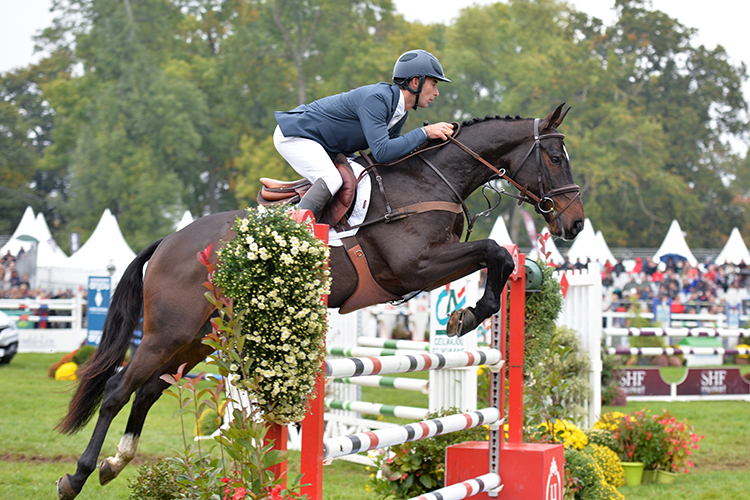
Astier Nicolas and Vinci De La Vigne at the World Young Horse Champs in Lion d’Angers
You decided to base yourself in the UK with Andrew Nicholson rather than France, what was your thinking?
“It was pure luck that I went there. I worked for Andrew Nicholson over there, and I loved it there. I had a scholarship at Hartpury College, then I came back because I was long listed for London and they told me I had to be in France. Then I was preparing here in France for Badminton and I had no yard, and someone said, why don’t you go back there, it’s the best place to prepare for Badminton. It was really beneficial, and I am still based there.”
“It is the best circuit of eventing in the world and obviously you benefit from that. There’s an event every weekend not far from your place and you are comparing yourself with the best every weekend. Not that we don’t have good riders in France but there are many good riders in England.”
Does that leave you a little cut-off from the French team management?
“Obviously a bit less, but we work quite closely, the phone exists. Before a championship, we have to come to France for a two and a half week training camp. I had to come in the winter also, for a training week, so I see them a lot. This year, they came to every big event.”
Is Serge Cornut part of your preparation?
“He’s probably the one I see the most because we do more dressage than anything else. He’s got a good contact with the riders, he was at the Olympics in dressage himself, he’s really competitive and he knows how to talk to us. He’s a friend to us, he’s not only a dressage trainer, he feels really involved. You end up really motivated every time he trains you.”
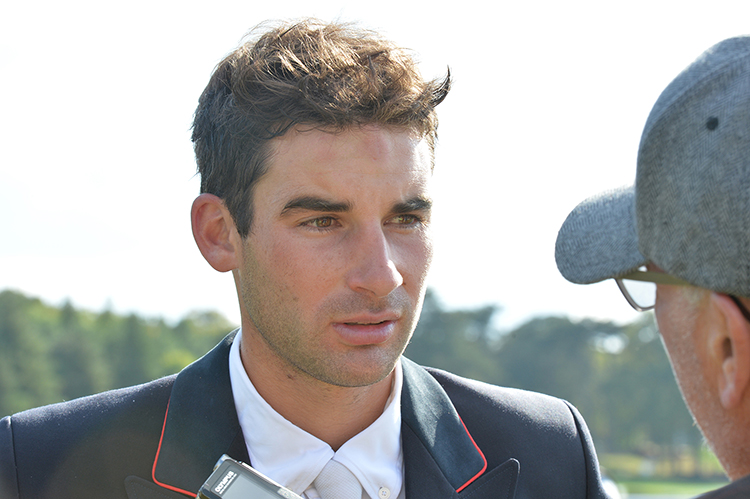
I was talking to the breeder of Piaf and he said, if it hadn’t been sent back by the first rider, no one would have ever heard of the horse…
“I think in everything in life, luck is important. That was pure chance that I got to ride Piaf.”
Right from the start did you say, wow this is going to be my Olympic horse?
“Yes. I trust a lot the horses I ride. I always loved the feeling on him. I was thinking of him as an Olympic horse, but I didn’t know what an Olympic horse was, but we got there. His strength is his brain, he tries really hard to do the job. He’s a good jumper, not always so easy, he’s got strength.”
Lots of pressure going into the showjumping at Rio?
“A bit less because we were in a team. I had pressure going into the ring, but I didn’t feel it so much, it was a very positive pressure.”
Thomas Carlile narrowly missed a place in the team for Rio, but he is a very thoughtful observer of the French scene, its strengths and weaknesses…
“We went through a really weak phase after the Athens Olympics. My belief is that the riders at the time, were very Federation dependent. There were a lot of contracts and financing from the Federation, and the Federation concentrated on a very small group of riders and horses. It worked very well, they were Olympic champions in Athens. Jean Teulère was world champion in Jerez in 2002, but then those horses started to age, and those riders had concentrated on their top horses and sold on their young ones. They hadn’t kept the good ones with potential coming up.”
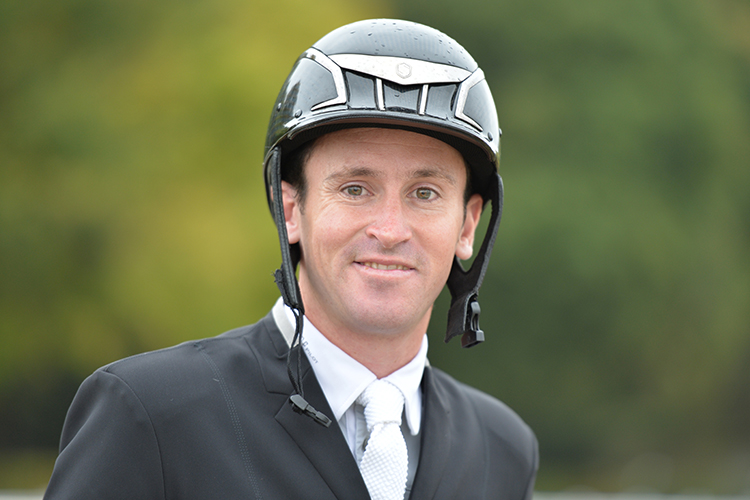
“The new generation of riders, Astier Nicolas, Maxime Livio, Mathieu Lemoine, myself, we sort of made ourselves at that time, with less support from the Federation and were much more independent. We each have our businesses, our structures are financially viable, and work. It was hard for us to get into the A Team at first, because the coaching staff were putting all the concentration on Group A. It was a bit like Catch 22, to get the good teaching you had to be in the A Team, but to get in you needed that coaching…”
“Basically when those horses weakened, we made ourselves known and started to knock on the door. We had plenty of young horses, and we were pin pointing their weaknesses to strengthen our strengths. Their dressage wasn’t their best phase, their jumping was good but they were still using old fashioned horses even though the chase and the roads and tracks had gone. It took us a couple of years to come up to their level, taken us a few years to produce better young horses and it has all started to fall into place.”
“I think the change of national trainer about five years ago, when Laurent Bousquet came in, shook up all the young riders and horses, and opened up the doors, then Thierry Touzaint came back and benefitted from that. We’re hungry, we’re starting out, we’ve got good horses and we are good riders.”
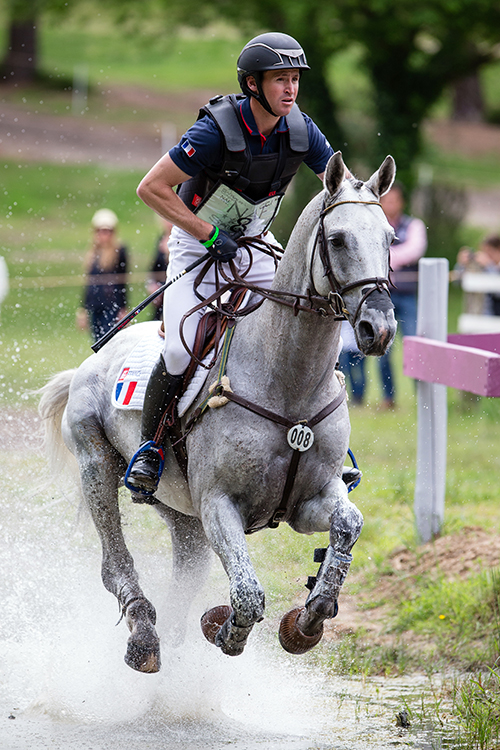
Upsilon and Thomas Carlile – starring at three star / Photo: Eric Knoll
“The big difference now is that we are all financially independent. If Maxime and I don’t get selected for Rio, I still have plenty of owners and my business carries on, and I look to the next event. It’s great for the nation because there’s now a good pool of good riders and horses, so hopefully the French team should be here for a while.”
It has been an interesting trip, criss-crossing France, taking to breeders, riders and team officials. It’s the horses, they keep saying, but wait – 50% of the team at Rio was ‘foreign’, one Dutch (dressage) horse, and a stallion from Hanover. Is it the trainers? Pierre Michelet’s courses? Luck? Or perhaps a mix of all of the above…
http://www.horsemagazine.com/thm/2016/12/french-eventing-what-made-france-great-part-one-the-breeders/

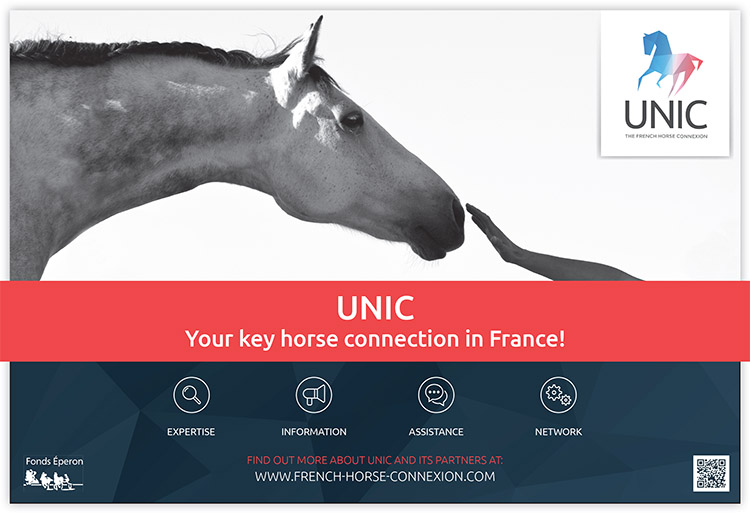
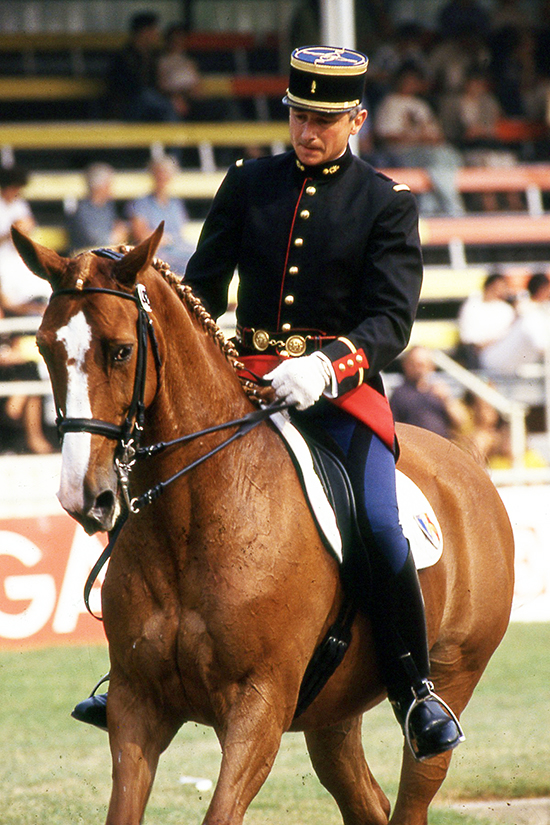
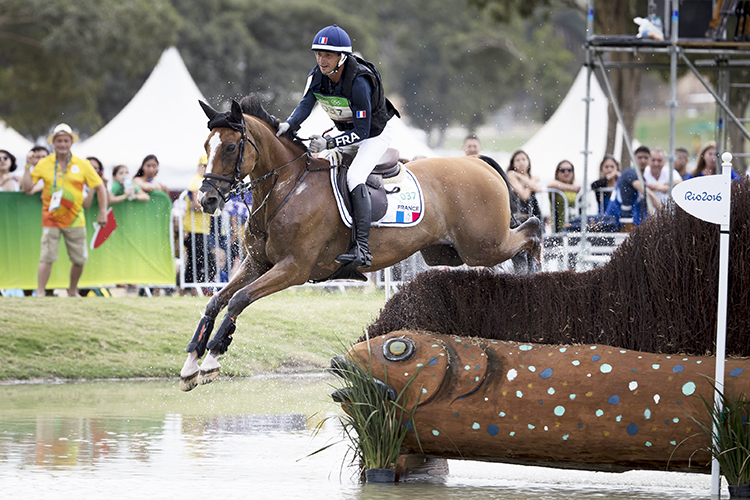
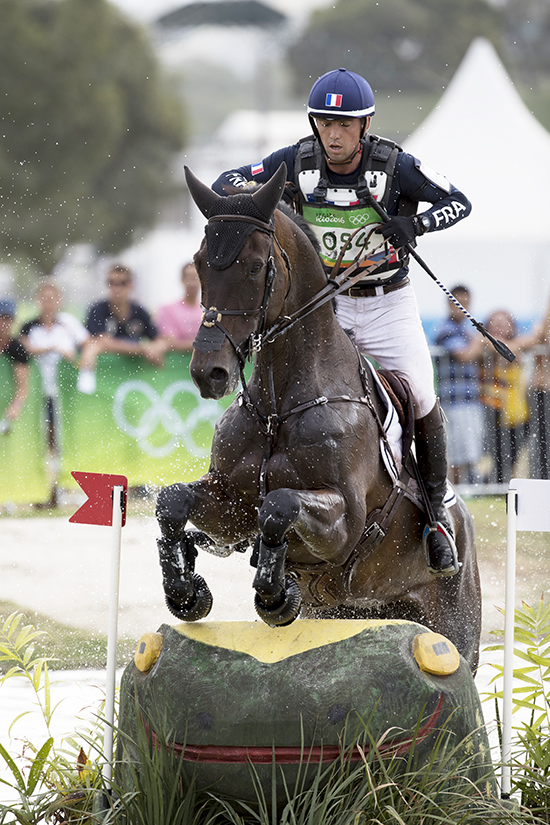
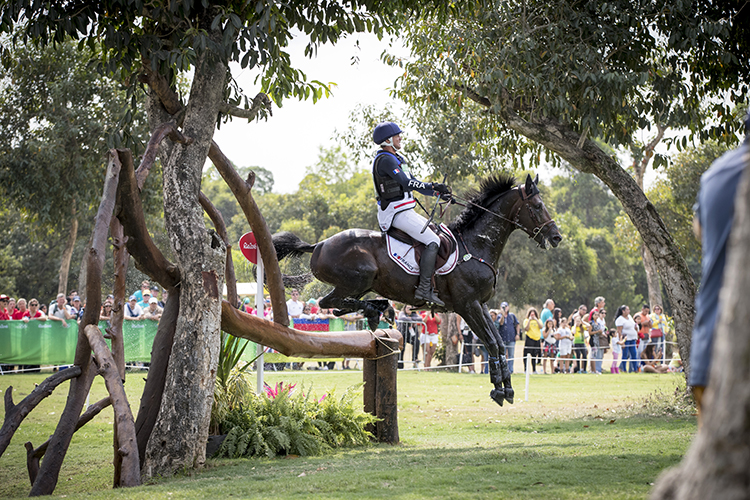
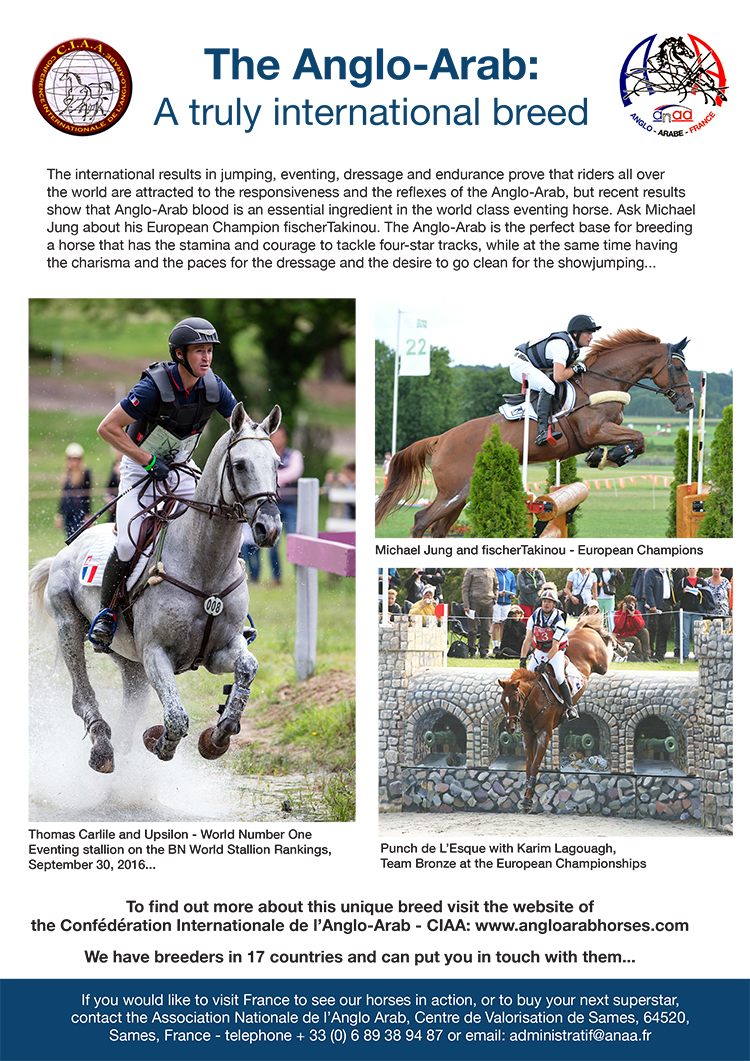
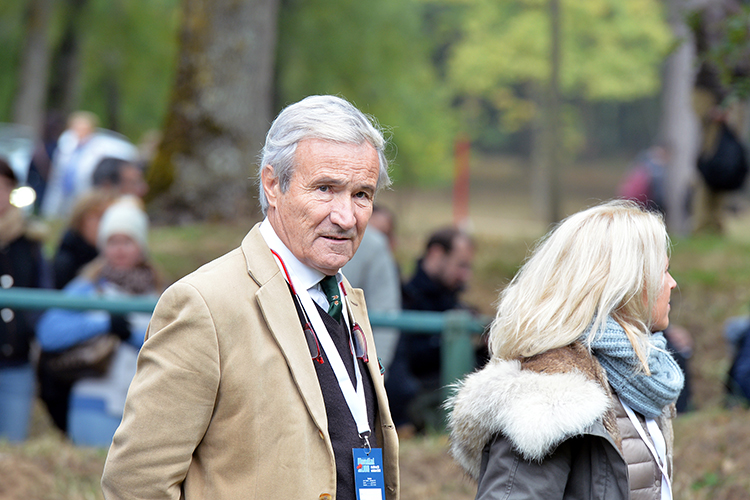

An interesitng article. Regarding the quote “It is not possible for an eventing horse to have the same dressage as a dressage horse, because the cross country requires a special balance” I am not sure I agree with this completely. Isn’t the goal of correct dressage training to improve balance? Why then would the requirement of this gymnastic activity be any different across disciplines? Isn’t it the ultimate goal of a rider to produce a horse that can do both, an idea commensurate with where the sport began? Talented riders such as Ingrid Klimke come to mind.